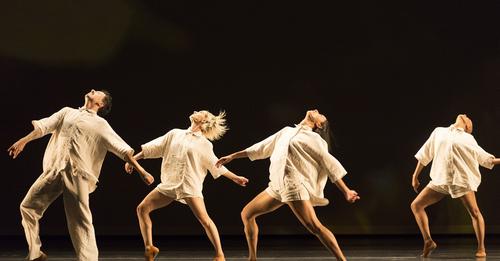
“Grupo Corpo” Artistic Director – Paulo Pederneiras; Choreographer – Rodrigo Pederneiras; Presented by Celebrity Series at Boch Center Shubert Theatre. Run has ended.
By Shelley A. Sackett
Founded in 1975 by Paulo and Rodrigo Pederneiras, the Brazilian dance company Grupo Corpo (meaning “Body Group” in Portuguese) is renowned for its unparalleled blend of popular Brazilian culture, African rhythms, and classical technique.
At last Saturday night’s performance, the troupe treated its audience to a mesmerizing evening of ingenious choreography, tireless, virtuoso dancers, inventive lighting and stage design, and pulsating, tribal-tinged music by Bahian songwriter Gilberto Gil and the Brazilian jazz band, Metà Metà.
The concert was as thrilling, riveting and entertaining as it gets.
In the first piece, “Gil Refazendi (Gil Remaking),” a subtly shifting abstract image of unfolding sunflowers is background to a stage lit by simple, single white light spots. (Scenography and lighting by the talented Paulo Pederneiras). The jazzy, infectious beat of ancestral drums, electronic distortions, African percussion gourds, and woodwinds sets the mood.
Known as the godfather of Brazilian music, Gilberto Gil’s compositions are high energy and uplifting, impossible not to sway and toe tap to. Conceived and then, post-pandemic, fully reconceived by choreographer Rodrigo Pederneiras, “Gil Refazendi” contains themes of renewal, rebuilding, and revitalization.
Female dancers explode onto the stage, alighting like beams of Tinkerbell magic clad in oversized white raw linen shirts and scanty shorts. The male dancers follow, dressed in the same breezy material cast as casual shirts over billowing pants (Costumes by Freusa Zechmeister). The effect is smooth, graceful, and playfully sexy.
Under Pederneiras’s mind-boggling choreography, the dancers stretch, pirouette, leap and undulate to the varying strains of samba, bossa nova and rock. They dance solo, as couples and in various groupings.
Although each dancer has their moment in the spotlight, what resonates most is the awe-inspiring synchronicity of the twenty-member troupe. When on stage as an ensemble, they move as a single organic whole. Not one wrist flicks out of tempo; not one back arches higher than another. That degree of skill and discipline is nothing short of astonishing and a rare pleasure to behold.
The second piece, “Gira,” is less abstract and more somber in tone. It is based on the rites of “Umbanda,” one of the most widely practiced Brazil-born religions that pulls on traditions from West African practices, Candomblé, Catholicism and others. In some Umbanda rituals, participants release control of their bodies to the spirits of ancestors or deities in what’s described as an altered state of consciousness.
Pederneiras’s choreography reflects gestures and movements he witnessed during actual ceremonies. There is a hint of menace in the air, particularly during the male/female couplings, which frequently teeter on the edge of violence before withdrawing back to more tender territory.
Male and female dancers are dressed identically, with naked torsos and white skirts of raw linen. Red paint on their necks adds a formal, sacramental touch. Again, the dancers are impossibly lithesome, transitioning from jolts of electric voltage to supple melting seamlessly. That they are dressed identically further blurs the edges between solo and troupe, between the individual and the collective.
Pederneiras started to choreograph in 1978 and has become known for the way in which he constructs sophisticated dialogues between music and dance using the bodies of his dancers as his interpreters. His work is a thrill to behold and one-of-a kind, a genuine reimagining of the ways in which humans can harness, express and appreciate the magic of creative energy.

